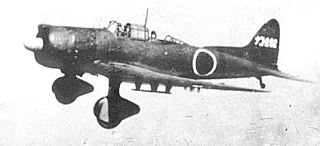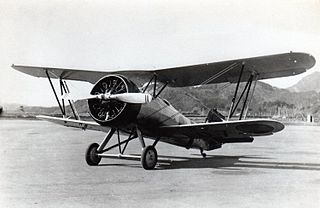Related Research Articles

Blackburn Aircraft Limited was a British aircraft manufacturer from 1914 to 1963 that concentrated mainly on naval and maritime aircraft.

Avro was a British aircraft manufacturer. Its designs include the Avro 504, used as a trainer in the First World War, the Avro Lancaster, one of the pre-eminent bombers of the Second World War, and the delta wing Avro Vulcan, a stalwart of the Cold War.

Junkers Flugzeug- und Motorenwerke AG more commonly Junkers, was a major German aircraft and aircraft engine manufacturer. It was founded in Dessau, Germany, in 1895 by Hugo Junkers, initially manufacturing boilers and radiators. During World War I and following the war, the company became famous for its pioneering all-metal aircraft. During World War II the company produced the German air force's planes, as well as piston and jet aircraft engines, albeit in the absence of its founder who had been removed by the Nazis in 1934.

The Mitsubishi A5M, formal Japanese Navy designation Mitsubishi Navy Type 96 Carrier-based Fighter (九六式艦上戦闘機), experimental Navy designation Mitsubishi Navy Experimental 9-Shi Carrier Fighter, company designation Mitsubishi Ka-14, was a WWII-era Japanese carrier-based fighter aircraft. The Type number is from the last two digits of the Japanese imperial year 2596 (1936) when it entered service with the Imperial Navy.

The Nakajima Aircraft Company was a prominent Japanese aircraft manufacturer and aviation engine manufacturer throughout World War II. It continues as the car and aircraft manufacturer Subaru.

Aichi Kokuki KK was a Japanese aerospace manufacturer which produced several designs for the Imperial Japanese Navy. After the war, the company was reorganized as Aichi Machine Industry Co., Ltd (愛知機械工業) where they made small kei cars until 1966 when they were integrated into Nissan and developed the Nissan Sunny and Nissan Vanette.

Caproni, also known as Società de Agostini e Caproni and Società Caproni e Comitti, was an Italian aircraft manufacturer. Its main base of operations was at Taliedo, near Linate Airport, on the outskirts of Milan.

The Mitsubishi Ki-67Hiryū was a twin-engine bomber produced by Mitsubishi Aircraft Company and used by the Imperial Japanese Army Air Service and Imperial Japanese Navy Air Service in World War II. While its original official designation was "Army Type 4 Heavy Bomber", in all of its key parameters, the Ki-67 was similar to the contemporaneous medium bombers of other countries. Japanese Navy variants included the P2M and Q2M.

Yokosuka Naval Air Technical Arsenal had many names, each depending on the period of its existence, and the circumstances at that time. Many of the names were acronyms that were derived from its military name or designation, which changed from time to time. The arsenal was sometimes known as "Kūgi-shō". The name Yokosuka prevailed however, even though it referred to the Arsenal's location at Yokosuka, Japan.

The Nakajima A4N was a carrier-based fighter used by the Imperial Japanese Navy, and the last biplane designed by Nakajima. The first prototype was completed in 1934, but due to engine trouble the aircraft did not see service until 1936. Given the Nakajima internal designation Nakajima YM, the Japanese Navy designation was Navy Type 95 Carrier Fighter. A total of 221 were built. It saw combat in the Second Sino-Japanese War in the late 1930s.

The Mitsubishi 2MR was a Japanese carrier-based reconnaissance aircraft of the 1920s, also known as the Navy Type 10 Carrier Reconnaissance Aircraft or the C1M in the Navy's short designation scheme. Designed for Mitsubishi by the British aircraft designer Herbert Smith, the 2MR was used by the Imperial Japanese Navy through the 1920s and 1930s.
Kawasaki Heavy Industries Aerospace Company is the aerospace division of Kawasaki Heavy Industries (KHI). It produces aircraft, space systems, simulators, jet engines, missiles, and electronic equipment.

The Mitsubishi 3MT5 was a Japanese bomber of the 1930s. It was a twin-engined biplane that was intended to operate from Japanese aircraft carriers, but proved to be unsuitable for carrier use, and the eleven aircraft built were instead used as land-based trainers.

The Mitsubishi 1MF10 or Mitsubishi Experimental 7-Shi Carrier Fighter (七試艦上戦闘機) was a prototype Japanese monoplane single-seat carrier-based fighter aircraft of the 1930s. Two were built for the Imperial Japanese Navy, but both were lost in crashes, with no production following.
References
- Gunston, Bill (2006). World Encyclopedia of Aero Engines, 5th Edition. Phoenix Mill, Gloucestershire, England, UK: Sutton Publishing Limited. ISBN 0-7509-4479-X.